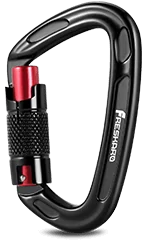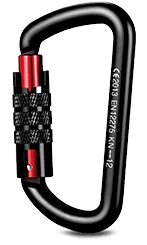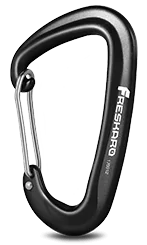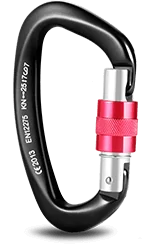Types of Carabiners, Climbing Carabiner Carabiner Clip Carabiner Keychain Locking Carabiner Carabiner Hook Heavy Duty Carabiner Large Carabiner Mini Carabiner Small Carabiner
Types of Carabiners
Different uses call for different kinds of carabiners. To choose and use them, you must first understand the differences—their shape, size, weight, strength, and gate type. Once you know the features to look for in a carabiner, think about your needs. What activities you’ll be using the carabiner for will determine which carabiner you can buy.
[lwptoc depth=”3″ hideItems=”1″ backgroundColor=”#ffffff”]
The Anatomy of a Carabiner Clip
Let’s introduce you to the parts of a carabiner clip. Many people indeed use devices that they may no know about. So for educational purposes, here is a nice diagram to give the knowledge bank a workout.
Carabiner Shapes
Asymmetric D Shape
The asymmetric D-shaped carabiner design has been a favorite for more than 20 years. That’s because it’s at its most robust, lightest, and most compact size. Our asymmetric D’s have less on one side to reduce weight even more and allow you to carry even more. Asymmetric carabiners tend to have larger gate openings than regular Ds. Asymmetric carabiners form the core of the majority of modern climbing gear.
[joomdev-wpc-pros-cons disable_title=”yes” wpc_style=”wppc-view2″ title_tag=”H4″ title=”” pros_title=”Pros” cons_title=”Cons” button_text=”Climbing Carabiner” disable_button=”yes” button_link=”” button_link_target=”_SELF” button_rel_attr=”dofollow” verdict_text=””][joomdev-wpc-pros]
- Large gate opening
- Strong but light
[/joomdev-wpc-pros][joomdev-wpc-cons]
- More expensive than other shapes
- Not as strong as the regular D shape
[/joomdev-wpc-cons][/joomdev-wpc-pros-cons]
Pear Shape
Pear-shaped carabiners are mildly asymmetric and have a wide gate opening to allow for easy clipping of ropes, knots, cables, and gear. They are primarily used for belaying and rappelling, but can also be used at anchor points on top-roping or multi-pitch climbing.
Some people call them HMS carabiners, and many are marked with an HMS on the spine. These are the best type of carabiners for use with a Münter hitch.
[joomdev-wpc-pros-cons disable_title=”yes” wpc_style=”wppc-view2″ title_tag=”H4″ title=”” pros_title=”Pros” cons_title=”Cons” button_text=”Get it now” disable_button=”yes” button_link=”” button_link_target=”_SELF” button_rel_attr=”dofollow” verdict_text=””][joomdev-wpc-pros]
- Large gate opening
- Explicitly designed for belaying and rappelling
[/joomdev-wpc-pros][joomdev-wpc-cons]
- Heavier and more expensive than most other shapes
- Not as strong as D and asymmetric D shapes
[/joomdev-wpc-cons][/joomdev-wpc-pros-cons]
D Shape
D-shaped carabiners are excellent for part of PPE equipment where safety is first, such as rock climbing, and provide an opening gate that’s wide enough to fit climbing rope or additional equipment. They hold loads off-center toward the stronger, non-gated side, so a smaller, lighter D carabiner can be just as strong as a larger oval. The need for locking gate is also important for climbing use.
[joomdev-wpc-pros-cons disable_title=”yes” wpc_style=”wppc-view2″ title_tag=”H4″ title=”” pros_title=”Pros” cons_title=”Cons” button_text=”Buy Screw Gate” disable_button=”yes” button_link=”” button_link_target=”_SELF” button_rel_attr=”dofollow” verdict_text=””][joomdev-wpc-pros]
- The Strongest shape
- Larger gate opening than oval shape
[/joomdev-wpc-pros][joomdev-wpc-cons]
- Smaller gate opening and heavier than asymmetric D shape
- More expensive than oval shape
[/joomdev-wpc-cons][/joomdev-wpc-pros-cons]
Oval Shape
No carabiner is more popular or enduring than the Oval. Despite its reputation for being cheap, the Oval has been widely used for over a century and is still considered one of the strongest all-around carabiners you can buy. They are commonly used for aid or mountain climbing.
Their shape provides more holding power than a D-shape carabiner, and their symmetry allows them to be used for carabiner brake rappels.
[joomdev-wpc-pros-cons disable_title=”yes” wpc_style=”wppc-view2″ title_tag=”H4″ title=”” pros_title=”Pros” cons_title=”Cons” button_text=”Get it now” disable_button=”yes” button_link=”” button_link_target=”_SELF” button_rel_attr=”dofollow” verdict_text=””][joomdev-wpc-pros]
- Uniform shape limits load shifting
- Hold more gear than D-shape carabiners
[/joomdev-wpc-pros][joomdev-wpc-cons]
- Smaller gate opening and heavier than other shapes
- Not as strong as other shapes
[/joomdev-wpc-cons][/joomdev-wpc-pros-cons]
Carabiner Gate Types
Straight Gate Carabiners
Straight-gate carabiners are made to be user-friendly and straightforward. These carabiners provide plenty of options for straightforward storage and usage. One straight gate biner can do many tasks in various situations on a climbing trip or otherwise. Bypass gates open with less force than standard wire gate carabiners, so ropes, slings, and webbing won’t twist up while clipping into protection.
Combining strength and safety, standard gate carabiners are designed to reduce the gate opening by giving the wire a slight kink at the point where it enters the locking mechanism. This makes them easier to clip and unclip, and they tend to be less likely to get hung up on your gear or another climber’s equipment.
[joomdev-wpc-pros-cons disable_title=”yes” wpc_style=”wppc-view2″ title_tag=”H4″ title=”” pros_title=”Pros” cons_title=”Cons” button_text=”Shop 26kN ” disable_button=”yes” button_link=”” button_link_target=”_SELF” button_rel_attr=”dofollow” verdict_text=””][joomdev-wpc-pros]
- Durable and easy to use
- Can feature a keylock nose for snag-free clipping operation
[/joomdev-wpc-pros][joomdev-wpc-cons]
- Heavier than wiregate
[/joomdev-wpc-cons][/joomdev-wpc-pros-cons]
Bent Gate
The simple clip-and-go gate bent style carabiner designed for a quick and easy way to set up a rope system. Bent gate biners are easy to clip with only one hand, making them great for routes where space is limited or clipping is complex—the primary use for the rope-end of quickdraws.
Bent-gate carabiners have an asymmetric shape and are ideal for applications where a symmetrical carabiner might cause the load to pinch or bind.
Wiregate Carabiners
Wiregate carabiners use loops made from stainless steel wire that is lighter than regular gates and don’t freeze shut as quickly. They also have a larger opening than other types of carabiners.
Wiregate carabiners weigh over 30% less than like carabiners and are constructed with fewer parts, making them less prone to breakage. They’re great for outdoor enthusiasts.
[joomdev-wpc-pros-cons disable_title=”yes” wpc_style=”wppc-view2″ title_tag=”H4″ title=”” pros_title=”Pros” cons_title=”Cons” button_text=”Shop Now” disable_button=”yes” button_link=”” button_link_target=”_SELF” button_rel_attr=”dofollow” verdict_text=””][joomdev-wpc-pros]
- Lightweight
- Help reduce gate lashing
- Less likely to be frozen shut
[/joomdev-wpc-pros][joomdev-wpc-cons]
- It can be less durable than solid straight and bent gates
[/joomdev-wpc-cons][/joomdev-wpc-pros-cons]
Locking Gate Carabiners
We design and manufacture locking carabiners for those who want a tool that is easy to use yet reliable and secure. Locking carabiners require no special knowledge of locking mechanisms to open and close, hence increase their versatility. You can be assured that a locking carabiner will be safe even if left hanging with the gate open since gravity will not exert force on the internal locking mechanism.
Screw-lock gates require the user to manually screw the sleeve to lock the gate.
Auto-lock carabiners automatically lock whenever the gate is closed.
Though heavier than non-locking models, unlocking carabiners are the only choice for use with a belay/rappel device. A locking carabiner used on the end of a “dog bone” sling connects your belay or rappel device to your harness. This allows for more freedom of movement, particularly during sport climbing. It also allows you to take advantage of the security offered by the locked gate.
[joomdev-wpc-pros-cons disable_title=”yes” wpc_style=”wppc-view2″ title_tag=”H4″ title=”” pros_title=”Pros” cons_title=”Cons” button_text=”12kN Autolocking” disable_button=”yes” button_link=”” button_link_target=”_SELF” button_rel_attr=”dofollow” verdict_text=””][joomdev-wpc-pros]
- Locking gate adds security
[/joomdev-wpc-pros][joomdev-wpc-cons]
- It can be heavier than other styles
[/joomdev-wpc-cons][/joomdev-wpc-pros-cons]
Carabiner Size, Weight, and Strength
Carabiner Size
Carabiners come in a variety of sizes, large and small. Large carabiners are typically easier to handle and more comfortable to clip, and they can hold more gear inside.
Smaller carabiners are lighter and take up less room on your rack, but they can be harder to clip.
Gate open clearance dimension is something to watch for when deciding on the size of the carabiner that you need. Not only does it tell you how much the gate opens, but it also means you the width of the bottom of the carabiner below the gate.
The right clearance allows the gate to open and close smoothly, without catching on the carabiner body or gate edge. Too much clearance causes the gate to be difficult to clip; too little makes your finger vulnerable to injury when clipping.
Carabiner Weight
It’s true that the lighter your rack, the better the climb. But bigger is not always better. Look at key factors like gate-open strength (how much weight it can hold open) and durability before deciding.
If you’re looking to save a few ounces on your next climbing trip, it’s smart to consider a lighter carabiner. But expect to pay more for those extra milligrams. Remember that small size can sometimes mean a more challenging time clipping the rope into quickdraws and bolts.
Carabiner Strength
Carabiners have three ratings that show how strong they are. The first is gate-open strength, the force between the gate and the nose of the carabiner. The second is minor-axis strength, or how strong a carabiner is when bent sideways. The third is major-axis strength, or how strong a carabiner is when pulled in the direction of its long side.
All climbing carabiners should meet UIAA and CE standards. Gate-open strength and minor-axis strength varies.
Smaller and lighter carabiners are generally weaker than bigger, heavier ones, but not always. Keeping an eye on the rating system is still the easiest way to stay safe.
If you’ve narrowed your search to a few different carabiners that will work well for your style of climbing, look at their strengths as one of the final decision points. If one carabiner provides everything you need and has greater strength than the others, then pick that one.
So which Carabiner To Use?
Once you know how to choose a carabiner, you can look at other factors such as gate type, size, weight, and strength. Once you understand how they affect performance, it’s easier to determine whether that carabiner is right for you. While you may be able to make a carabiner work for your needs, the best carabiner for that purpose may not be the lightest aluminum option. Choose a carabiner with features that will best complement your intended use.
A Climbing Carabiner
Choosing the right carabiner is important because a carabiner’s capacity to hold your weight and resist gate flutter (the amount of force it takes to flip the gate open) is dependent on how big the carabiner’s body is. For example, if you’re going climbing with a lightweight quickdraw, having small wiregate carabiners at each end will reduce the weight significantly and make carrying less gear up the hill easier.
The way carabiners are used depends on the type of climbing you’re doing. A wiregate carabiner is great for racking gear to keep your rack light for alpine climbing or adventure racing. Large carabiners with a lever-lock gate are great for belaying.
Climbing carabiner colors and shapes can vary depending on their intended use. Shaped wiregate carabiners are smaller, lighter, and have a lower gate pressure making them easier to clip when you’re working with longer draws and slings. Some may be better for racking gear, while others are better for clipping a rope.
Generic Use Carabiner
The practical uses of all types of carabiners are numerous, just doing a google search brings up a vast array of what people have used them for, you can check this Pinterest link which shows some terrific ideas. The only consideration is mostly down to convenience or secure locking, with secure locking being the choice for when an item needs a more secure way to hold/lock an item together.
Our 12kN carabiner is and has been a choice for non-climbing uses. You can check our auto-locking model reviews on Amazon, there are some images that give you an idea of what people have used for. And screw-lock for hanging items also has great feedback on Amazon, we take care and read all the customer comments and verify and validate any problems.



